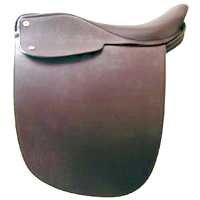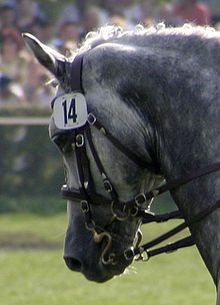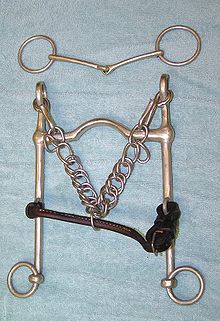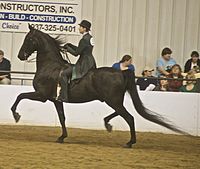Flat Seat (AKA Park Seat and  Saddle Seat Equitation) Saddle Seat Equitation) 
Note: As with other events governed by the United States Equestrian Federation, the discipline name is two words, not one, "Saddle Seat".
What is saddle seat (AKA flat seat or park seat) equitation? Is there a specific kind of horse that this seat is well-suited? Conformationally the horse should have a naturally upright neck with a high head carriage. The gaits should be animated and the action should be high. The horse should be very energetic but still responsive to the rider. This form of riding is generally used with many of the gaited horse breeds such as the American Saddle Bred, Tennessee Walking Horse, Racker, Rocky Mountain Horse, Kentucky Mountain Horse, Missouri Fox Trotters, Paso Finos, Hackneys, National Show Horse, Mountain Pleasure Horses, etc. It may also be used with Morgans and Arabians. Less often Friesians and Andalusians are also shown in saddle seat. The American plantation horses covered allot of ground with comfortable gaits and the saddle seat used a saddle with a "flat seat." This was an American phenomena. The park seat terminology grew out of the exhibition of high stepping horses in public venues--often exhibitions in city parks in Europe on Sundays.
 
Saddle Seat, Flat Seat or Park Seat Saddle (left) and Double bridle, with both curb and snaffle bits (right) 
Detail of a bit and bradoon: Long-shanked curb and thin bradoon traditional in Saddle seat style riding ..."The saddle seat horse traditionally wears a double bridle (full bridle), with both a curb bit and a bradoon. A pelham bit is also legal for pleasure classes, though not common. The double bridle is preferred (and mandatory in most equitation classes) because it allows more fine-tuning of the horse's head and neck position, though a pelham can be used in a few specialized classes such as Saddlebred Pleasure Equitation. A single curb bit is used for gaited horses such as the Tennessee Walker and Missouri Fox Trotter. The shanks of the curb bit are often longer than those found on the Weymouth style double bridle used in dressage, often 7 inches in overall length (some breeds have length limits in the rules). The browband is commonly brightly colored leather or vinyl, red being the most common color. The cavesson is sometimes plain leather, and sometimes colored to match the browband, depending on breed and fashion trends in tack."...  Saddle Seat Saddle Seat 
"The walk, trot, and canter are shown in the saddle seat as well as five gaited equitation classes which show two additional gaits--the slow gait and the rack. All classes require Rail work, where competitors show and are judged as a group going both ways of the arena. Saddle seat equitation may include individual tests or a pattern to be ridden. Tests may include backing up, mounting and dismounting, riding without stirrups, 'addressing' the reins (i.e. picking up the four reins correctly), figure eights, serpentines and straight line patterns done at any gait. At the canter, only simple changes of lead are required when changing directions. It is possible to have a 'ride-off,' where two or more riders are asked to perform additional work to determine the winner.
Correct position for the rider is to have the shoulder, hip, and heel in a line. He/she is also to have a straight line from knee to toe, and from elbow to wrist to the horse's bit. The rider's back should be straight yet relaxed, and the legs and arms are to remain virtually motionless. It should also be noted that the rider is "behind the motion", that is, not forward (hunt seat), not centered (balance seat), but a bit back to allow the horse to step high in its gaits.

A properly attired saddle seat rider, showing solid equitation form.
The informal dress for saddle seat equitation includes a coat and Kentucky jodhpurs of a dark, conservative color, e.g., herringbone, pin stripes, black, blue, grey, dark burgundy, dark green or beige; a white or pastel collared shirt with a tie; derby or soft hat; and jodhpur boots. Vests and gloves are optional. After 6 p.m. formal wear is required. This habit includes a tuxedo-style jacket, pants and vest with bow tie and formal shirt, and top hat.
Pleasure equitation is another form of saddle seat equitation in which a rider is required to wear informal dress (coat, jodhpur pants, derby or soft hat, all in a dark color) in the day and evening and ride a horse that has a full mane and tail which is not set. ..."
For More Information:
 Equitation Equitation 
Saddle Seat World Cup, 
American Royal Horse Show 
Bits
|